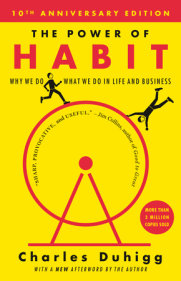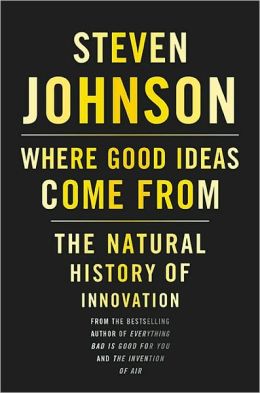 Habit, it turns out, means more than just subconsciously grabbing a toothbrush using the same hand all the time. During the time of WWI when brushing wasn’t a habit, professional salesmen had to go door to door selling toothpaste, often with so poor a result that toothpaste companies suffered financial loss and the government considered the state of oral health to be of national concern. Leveraging tendencies in human habit and creating a craving through leaving a clean feeling in the mouth, however, Americans learned to brush, earning fortunes for the companies involved and left many with much better teeth. Through this and many other examples, Duhigg shows habit’s impact in businesses, civic movements, and an individual’s well being.
Habit, it turns out, means more than just subconsciously grabbing a toothbrush using the same hand all the time. During the time of WWI when brushing wasn’t a habit, professional salesmen had to go door to door selling toothpaste, often with so poor a result that toothpaste companies suffered financial loss and the government considered the state of oral health to be of national concern. Leveraging tendencies in human habit and creating a craving through leaving a clean feeling in the mouth, however, Americans learned to brush, earning fortunes for the companies involved and left many with much better teeth. Through this and many other examples, Duhigg shows habit’s impact in businesses, civic movements, and an individual’s well being.
Fundamental to the forming of habit is the “habit loop”, consisting of a trigger, a routine, and finally, a reward. Once a routine has been performed many times with a reward following it, the brain identifies a trigger – a signal which is always associated with the ensuing routine, and engages the proper “autopilot” routine in the brain to perform the sequence of actions to get to the reward. For a habitual smoker who lights a cigarette when feeling the need to relax, that feeling of tension is the cue triggering the routine of smoking.
Finally, the reward (a sense of relief in the smoker example) reinforce the habit loop, flagging it to our mind as being a worthwhile habit to keep, prodding the brain to seek ever more efficient ways to perform the routine, and gradually creating a craving, such that when a cue is given, one’s brain already anticipates and expects the reward. If the reward is absent, however, feelings of disappointed and frustrated would arise – the stronger the habit, the stronger the emotions.
My favourite part of the book is in seeing the extraordinary similarities of human behaviours between individuals as manifested by the predictions of commercial software. Retailers know a few things about its consumers. First, buyers of a particular profile – say the same gender, age, wealth, and occupation – have fairly similar and persistent buying patterns. Secondly, though many shoppers try to stay to their shopping list, most purchasing decisions are made during their time in store. And thirdly, one is most susceptible to marketing influence such as placement, shelving, and display of products in the store when major life changes happen, such as a job change or family relocation.
All this adds up to one particular customer profile being exceptionally lucrative – couples with newborns. Babies cost money – by their first birthday, the average spending on each is close to $7000. That’s just a start. Parents with a newborn are so deprived for time and energy that they will purchase everything in one location, during a time when such a life changing event renders them most malleable to advertising influence. Soon, where they get diapers will get to sell them orange juice, movies, and many more items. It is why retailers go to great lengths to court parents of newborns, even visiting maternity wards in hospitals.
But by the time a baby is born, the competition for that customer is too fierce. Could it be possible to win the moms over before others got to them? Target, a leading retailer, wondered if they could somehow find out who are the expecting mothers through their buying patterns. Target’s group of mathematicians, scientists, and programmers experimented, and found they could – that 25 products, if purchased in a certain sequence and over a period of time, predicts quite accurately if the buyer is expecting a new baby. Through the loyalty program data, Target would then send relevant marketing material to entice the customers ahead of competitors. This program was so successful it contributed to Target’s profit rise from 44 to 65 billion between 2002 and 2009.
Besides the retailing world, Duhigg shows that software algorithms are now employed to predict the future success of songs in the music industry, and in casinos to forecast individual’s gambling behaviour, precise to the minutes and cents. It reminded me of the talks that professor Larry Smith gave on expert systems.
Brain scans show that once a habit is formed it is etched in our neural pathways. Trying to completely quash the desire to indulge in old habits through willpower alone is therefore often fruitless. It’s why many who quit smoking “cold turkey” without other support can succumb to it all the more upon encountering major life stresses.
Bad habit may now seem like an insurmountable force that enslaves us, but Duhigg is more optimistic, and argues throughout the book that though persistent, habits are like muscles and can be weakened and also reframed. Through patient self examination to find the triggers, and carefully cultivating new routines and experimenting with rewards that one responds to, habits can be changed. Using again the smoker example, some have found the use of meditation as the routine (instead of lighting the cigarette) when the trigger of tension arises to be useful. Others find this not at all, and try other methods.
Habit change then, can be a very drawn out process in self exploration that requires much motivation and an understanding that what seems like a string of failed attempts are actually experimentation toward betterment. In addition, new habits can also be cultivated, and by weakening the old habit loops, can overtake the old habits. It also bears mentioning that the power of habit works equally strong on the good habits too, and while bad habits may be devastating, good habits can be a significant force for good.
I’m not sure habit is destiny, but it is powerful – and the book showed a myriad of examples for its downside and upside. In closing, Duhigg writes:
This is the real power of habit: the insight that your habits are what you choose them to be. Once that choice occurs – and becomes automatic – it’s not only real, it starts to seem inevitable, the thing as [William] James wrote, that bears ‘us irresistibly toward our destiny, whatever the latter may be.’




 Habit, it turns out, means more than just subconsciously grabbing a toothbrush using the same hand all the time. During the time of WWI when brushing wasn’t a habit, professional salesmen had to go door to door selling toothpaste, often with so poor a result that toothpaste companies suffered financial loss and the government considered the state of oral health to be of national concern. Leveraging tendencies in human habit and creating a craving through leaving a clean feeling in the mouth, however, Americans learned to brush, earning fortunes for the companies involved and left many with much better teeth. Through this and many other examples, Duhigg shows habit’s impact in businesses, civic movements, and an individual’s well being.
Habit, it turns out, means more than just subconsciously grabbing a toothbrush using the same hand all the time. During the time of WWI when brushing wasn’t a habit, professional salesmen had to go door to door selling toothpaste, often with so poor a result that toothpaste companies suffered financial loss and the government considered the state of oral health to be of national concern. Leveraging tendencies in human habit and creating a craving through leaving a clean feeling in the mouth, however, Americans learned to brush, earning fortunes for the companies involved and left many with much better teeth. Through this and many other examples, Duhigg shows habit’s impact in businesses, civic movements, and an individual’s well being.






